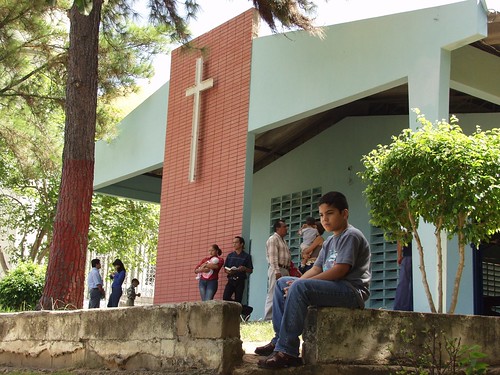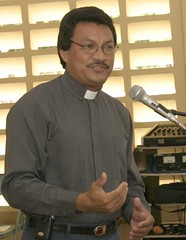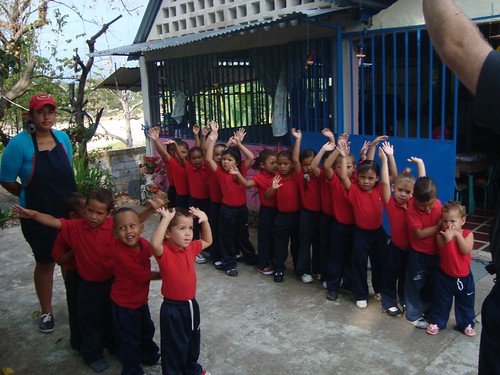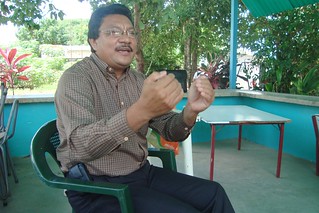 |
| Ascension Lutheran Church |
Our mission is affiliated with the Lutheran Church of Venezuela, a national church-body with only 15 congregations scattered from one end of the country to the other, and a total of 930 baptized members in a nation of 30 million people. The national church has requested prayers for one of its largest congregations, Ascension Lutheran Church of San Felix de Guayana in eastern Venezuela.
The city of San Felix is located on one side of the Orinoco and Caroni rivers with the city of Puerto Ordaz on the other. Much like Minneapolis and St. Paul, Minnesota, the two communities form one metropolitan area, known as Ciudad Guayana, which constitutes the sixth-largest city in Venezuela.
 |
| Pastor Elias Lozano |
Ascension Lutheran Church has been nestled on the same hillside property for more than 40 years. Now an agency of municipal government wants to seize all of the land and destroy all of the exisiting buidlings, including the church itself and the house where Pastor Elias Lozano and his family live.
Ostensibly, this is for the purpose of constructing a housing project. Of course, this action demonstrates appalling disregard for a house of prayer and the fundamental rights of the people who gather for worship there. But anyone who has paid attention to international headlines can sense that this is part of a trend toward diminished priority placed on religious liberty around the world, even in the United States.
Perhaps one might ask how you can compare unjust confiscation of property with the beheading, burning and crucifixion of Christians in the Middle East and other places? Because once the basic principle of freedom of religion is undermined, it is only a matter of time before violent persecution of religious dissidents follows. As Christians, we recognize that the impulse for persecution, no matter how mild it may seem in the beginning, or how severe it may become, stems from the same spiritual source.
“I have said all these things to you to keep you from falling away. They will put you out of the synagogues. Indeed, the hour is coming when whoever kills you will think he is offering service to God. And they will do these things because they have not known the Father, nor Me." John 16: 1-3 ESV
 |
| Worship at Ascension Lutheran Church. |
Jesus repeatedly told His disciples that His hour would come, the time when He would suffer and die on the cross to atone for the sins of the world, before rising from the dead on the third day. In these verses from the Gospel of John, He warns them that their time will come, when they will suffer and even die for the sake of their faith. Jesus both warned His disciples of persecution and hatred, and gave them encouragement that all these things would happen in accordance with God’s counsel and will or by His permission. The hatred of the world, of the children of unbelief, would be shown in various forms or degrees. First would come ostracism by their fellow Jews and denial of the right to public worship. But bigotry and hatred against Christ and His followers would not be satisfied with such measures, but would not even shrink back from murder as a work of great merit and well pleasing to God. These words have been and are being fulfilled continually.
St. Paul repeated this warning in 2 Timothy 3: 12-13, "Indeed, all who desire to live a godly life in Christ Jesus will be persecuted while evil people and impostors will go on from bad to worse, deceiving and being deceived. " All who truly are eager to live a life of godliness in Christ, through the power which He imparts, all believers that give evidence of their faith in Christ in a life that accords with the will of God, must bear also the cross of Christ, whether in the form of ridicule and ostracism, or actual martyrdom.
The early Christians first earned the wrath of others of Jewish background who did not believe in Jesus as Lord and Savior because He did not meet their expectations of a superhero who would overthrow the hated Roman Empire and restore Israel to its ancient glory. As the Gospel spread throughout the wider Greco-Roman world, Christians were persecuted by those who personally profited from idolatry (Acts 16: 16-24; 19: 23-41) and those who feared that exclusive worship of just one God would anger rival deities and thus bring down all kinds of misfortune on the people. In Acts 17: 16-34, St. Paul noted that ancient Athens had altars dedicated to all the known gods and goddesses of the Mediterranean world, plus one to "the unknown god", just in case there was one that they had overlooked.
Finally the early Church faced a series of systematic campaigns to "stamp out" Christianity from the highest levels of Roman government. The problem here was the refusal of Christians to participate in even token worship of the Roman emperor, for they believed such absolute devotion belonged to God alone. But the Church endured these onslaughts and by the end of the fourth century A.D., Christianity had become the majority religion of the Roman Empire.
In the centuries that followed, the militant religion of Islam became the most visible threat to the lives and liberty of Christians. Even within "Christian" lands, those who stood up for the pure Word of the Scriptures against the over-reaching authority of the institutional church and the civil goverment often became targets of violent persecution.
And so it remains to this day and until the Lord returns in glory. I was blessed by God to grow up in a country with one of the highest standards of religious liberty in the world and in history. But recent events have shown that even those of us who have enjoyed this privilege should not take it for granted.
So let us pray for the liberty of Christians in Venezuela, the United States and China, and the very lives of those in the Middle East, Africa and elsewhere. Let us rejoice that the Lord is with us always, even to the close of the age. Amen.

















